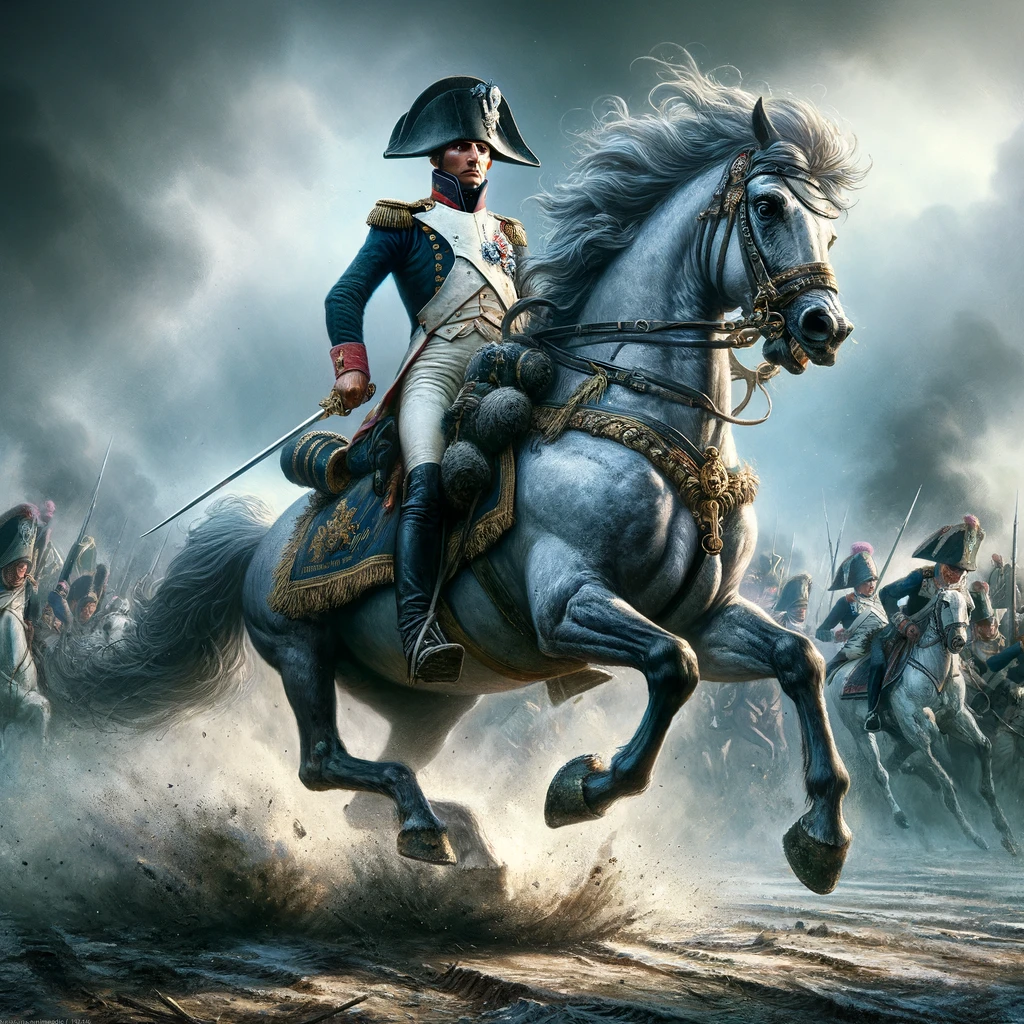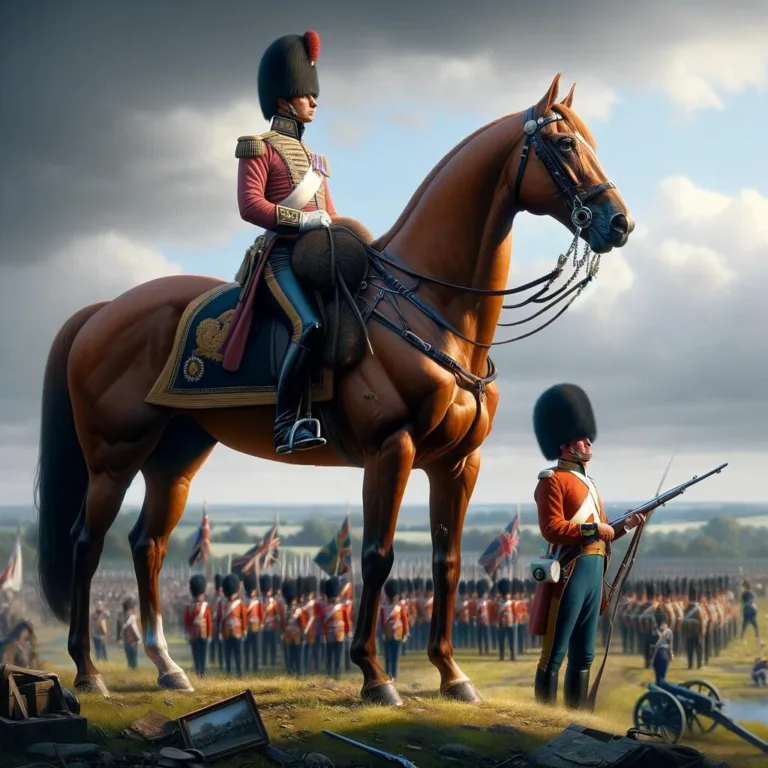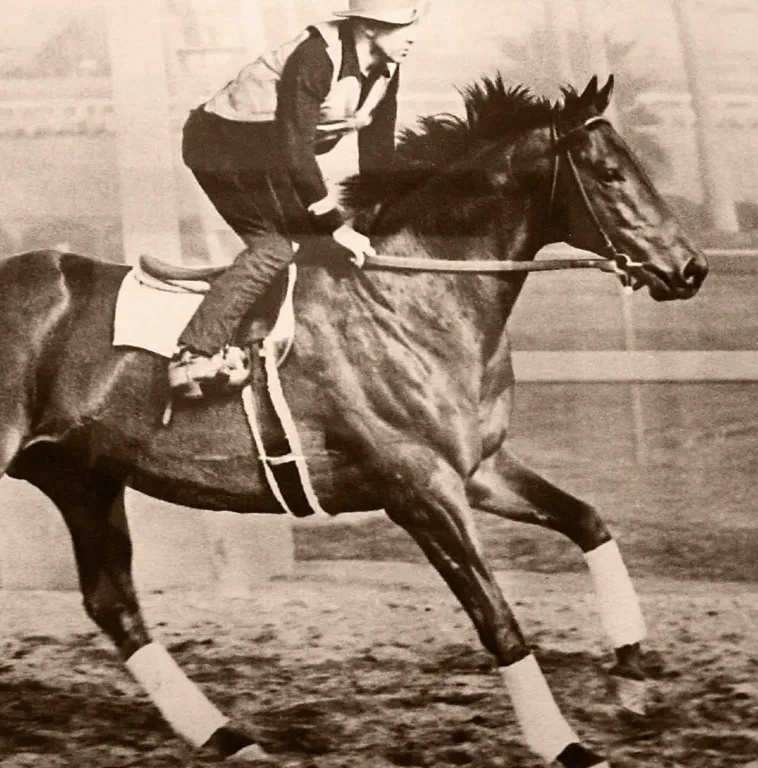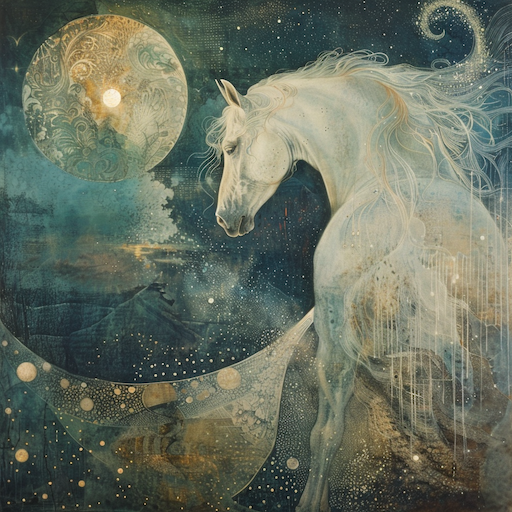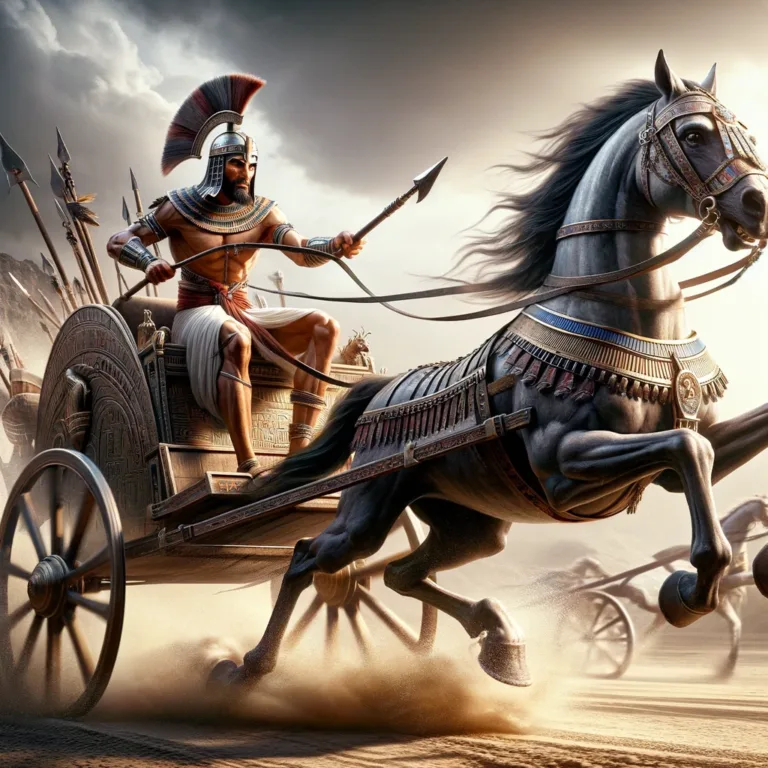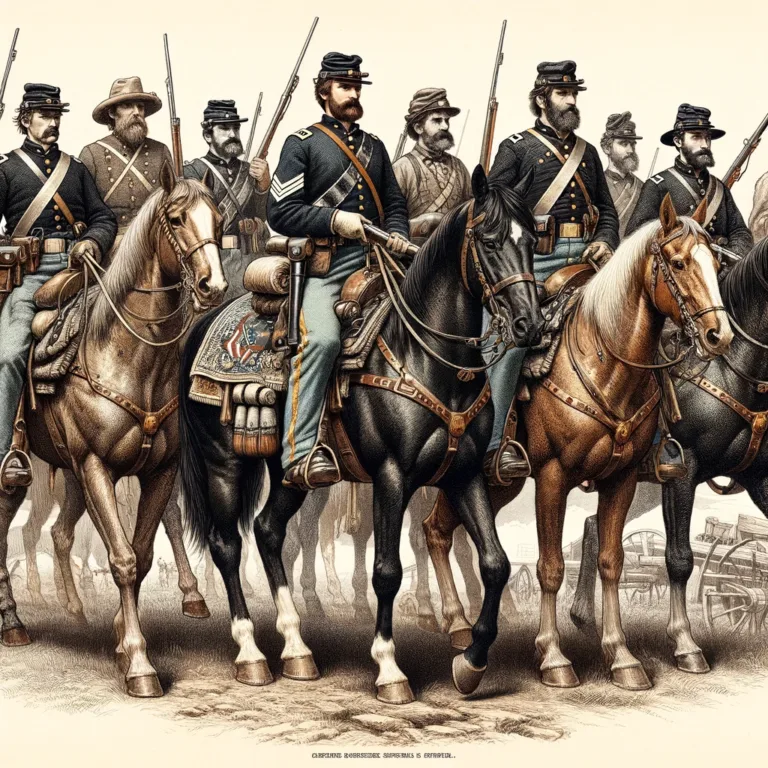Marengo: The Legendary Steed of Napoleon Bonaparte
Marengo, the famed Arabian steed of Napoleon Bonaparte was born in 1793. This exceptional horse emerged not only as a witness to pivotal moments in European history but also as a symbol of the unwavering bond between a leader and his loyal companion.
Marengo’s story transcends the typical tales of warhorses. His name, often spoken in the same breath as his illustrious rider, has become synonymous with loyalty, endurance, and the extraordinary demands placed upon warhorses of his era. His breed, an Arabian, renowned for its agility, intelligence, and stamina, played a crucial role in Marengo’s ability to endure the harsh conditions of battle and the long marches that marked the Napoleonic campaigns.
The fascination with Marengo extends far beyond the battlefield. In equestrian circles, he is revered not only for his physical capabilities but also for his remarkable temperament, a quality essential for a horse in the chaos of war. Historians, on the other hand, delve into Marengo’s story as a unique lens through which to view the Napoleonic Wars, offering insights into how cavalry and mounts were utilized during this era.
Marengo’s legacy, preserved in paintings, literature, and even in skeletal remains, continues to be a subject of study and admiration. His life, intertwined with that of one of history’s most famous military leaders, serves as a testament to the enduring connection between humans and horses. This article aims to explore the life and tales of Marengo, shedding light on his remarkable journey from the stables of an Arabian breeder to the battlefields of Europe, standing steadfast by the side of Napoleon Bonaparte.
The Origin and Breed of Marengo
Marengo, named after the Battle of Marengo where Napoleon secured a crucial victory, was a striking grey Arabian horse born in 1793. His origins, though shrouded in the mists of history, point to the deserts of the Middle East, the cradle of the Arabian breed. This breed, one of the oldest and most influential horse breeds in the world, is renowned for its beauty, elegance, and particularly the characteristics that made Marengo an exemplary warhorse.
The Arabian horse, with its distinctive head shape and high tail carriage, is not just prized for its aesthetic appeal but also for its incredible physical attributes. Arabians are known for their endurance, a trait essential for the long and grueling military campaigns that marked the Napoleonic era. This endurance did not come at the cost of speed; Arabians are remarkably swift, an attribute that undoubtedly gave Napoleon and Marengo an advantage on the battlefield.
But Marengo’s suitability as a warhorse extended beyond his physical capabilities. The intelligence of the Arabian breed is well-documented, characterized by a keen alertness and a remarkable ability to learn and adapt to challenging situations. This intelligence, coupled with a natural propensity for a strong bond with their riders, made Marengo an ideal companion for Napoleon, who required more than just a mount for transportation but a reliable partner in the tumultuous environments of war.
Marengo’s size also played a role in his effectiveness. Standing at about 14.1 hands (approximately 57 inches or 145 cm), he was not the largest horse in the cavalry. However, this relatively modest stature allowed for greater agility and maneuverability, crucial in the chaotic throes of battle.
The Arabian breed’s influence extends beyond its physical characteristics. Known for their spirited yet manageable temperament, Arabians possess a unique combination of courage and calmness, traits that are indispensable on the battlefield. It’s this combination that allowed Marengo to withstand the noise and confusion of combat, remaining composed under circumstances that would unnerve less stalwart breeds.
In Marengo, the finest qualities of the Arabian breed were exemplified. His endurance, speed, intelligence, and temperament were the attributes that made him not just a mount, but a legend. His story is not just a tale of a horse but a testament to the breed that has captivated horse lovers for centuries.
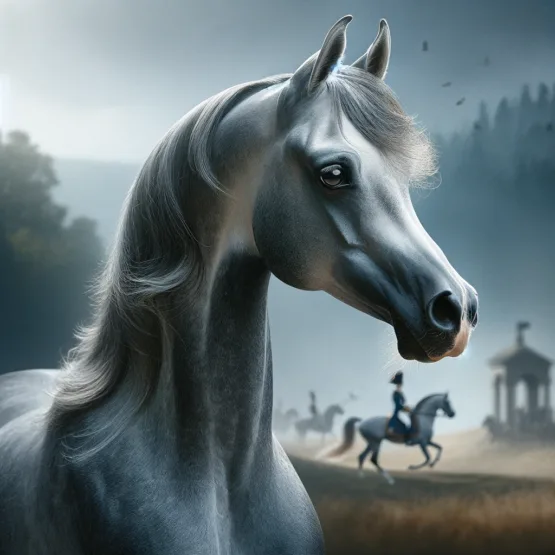
Marengo and Napoleon: A Formidable Partnership
The story of how Napoleon Bonaparte, one of history’s most formidable military leaders, came to acquire Marengo intertwines fate with foresight. Marengo entered Napoleon’s life in 1799, when the future emperor was actively bolstering his cavalry. Acquired from the Ottoman Empire, Marengo was not just chosen for his breed’s esteemed reputation; he was selected for qualities that Napoleon deemed essential for his personal mount in the rigorous campaigns ahead.
From the outset, the bond between Napoleon and Marengo was more than that of a rider and his horse; it was a partnership forged in the crucibles of war. Napoleon, a consummate horseman himself, recognized in Marengo a steadfastness and resilience that mirrored his own. In the early stages of their association, the duo underwent numerous trials, both on and off the battlefield, which strengthened their bond and mutual trust.
Marengo’s temperament was a key factor in his becoming Napoleon’s preferred mount. Arabians are known for their spirited yet manageable nature, and Marengo exemplified this balance perfectly. He was calm and unflappable amidst the chaos of battle, a trait that is not just desirable but essential for a military commander’s horse. His ability to remain composed under cannon fire and amidst the clash of arms was remarkable, providing Napoleon with the stability and reliability he needed to lead and make decisions in battle.
Moreover, Marengo’s reliability extended to his physical prowess. He possessed a remarkable ability to cover long distances at a swift pace, a necessity for the rapid maneuvers often employed in Napoleonic warfare. His endurance, a hallmark of the Arabian breed, meant that he could sustain a high level of performance over prolonged periods, often in harsh and varied terrains.
Napoleon’s reliance on Marengo was also a testament to the horse’s intelligence and adaptability. Marengo showed an acute awareness of the battlefield environment, reacting intuitively to shifts in the situation. This intelligence, coupled with his physical attributes, made him an indispensable asset to Napoleon.
The partnership between Napoleon and Marengo became legendary, with Marengo carrying the emperor in numerous battles. Their relationship was not merely functional; it was emblematic of the deep connection that can exist between a horse and rider, especially under the extreme conditions of war. In Marengo, Napoleon found more than a horse; he found a loyal companion, a bearer of his triumphs and trials, a living symbol of his military might and leadership prowess.

Marengo in the Heat of Battle
Marengo’s legacy is indelibly linked to his role in some of the most significant battles of the Napoleonic era. His presence in these battles not only demonstrates his importance to Napoleon but also highlights the extraordinary demands placed on warhorses of that period.
Austerlitz, 1805: The Battle of Austerlitz, often hailed as Napoleon’s greatest victory, saw Marengo under the Emperor in a display of tactical brilliance. Marengo’s agility and endurance were pivotal in the rapid maneuvers and extended engagements of the day. The battle, characterized by complex movements across difficult terrain, exemplified Marengo’s ability to maintain steadiness under pressure, a crucial element in surprising and outflanking the enemy.
The Battle of Jena, 1806: In this decisive encounter against the Prussian army, Marengo again proved his mettle. The battle required swift, relentless pursuit, and Marengo’s enduring stamina and speed were instrumental in Napoleon’s comprehensive victory. His ability to navigate the chaotic battlefield, maintaining poise amidst the turmoil, was a testament to his remarkable training and temperament.
Wagram, 1809: This fiercely contested battle against the Austrian army showcased Marengo’s resilience in one of the most grueling campaigns. The battle stretched over two days, demanding not only physical endurance but also mental fortitude from both horse and rider. Marengo’s consistent performance under such prolonged stress and exhaustion underlined his extraordinary capabilities as a warhorse.
The Russian Campaign, 1812: Perhaps the most demanding of all was the Russian Campaign, where Marengo’s endurance was pushed to its limits. The harsh conditions and the retreat from Moscow tested the resilience of both horse and rider. Marengo’s ability to endure the severe cold, scarcity of food, and the rigors of a long retreat highlighted not just his physical strength but also his unyielding spirit.
In each of these battles, Marengo exemplified the qualities essential in a warhorse: speed, stamina, intelligence, and above all, courage. The physical demands on such horses were immense; they were required to carry heavy loads, including a rider in full military attire and often equipment, over long distances and often at great speed. They had to be responsive and quick, able to change direction or pace at a moment’s notice.
Mentally, warhorses like Marengo faced the chaos and noise of the battlefield, which could easily spook or unnerve less steadfast animals. Marengo’s ability to remain calm and focused amidst the cacophony of war speaks volumes about his temperament and the trust he placed in Napoleon.
Marengo’s participation in these battles is not just a series of historical footnotes; it’s a saga of a horse who, with unwavering courage and resilience, played a critical role in shaping European history alongside his famed rider.
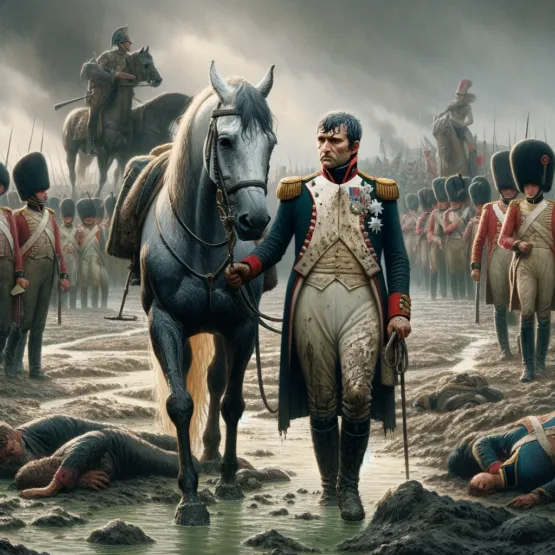
The Capture and Later Years
The Battle of Waterloo in 1815, a pivotal moment in European history, marked not only the downfall of Napoleon but also a dramatic turn in the life of his faithful steed, Marengo. Captured by the British forces after the defeat of the French army, Marengo’s life took a path as extraordinary as the battles he had once galloped through.
Captured at Waterloo: The capture of Marengo at Waterloo was symbolic, representing the end of an era. Despite the chaos and the French defeat, Marengo’s capture was not merely an incidental war trophy. He was recognized and valued for his association with Napoleon, a testament to the horse’s fame and the esteem in which he was held.
Life in England: Marengo’s subsequent life in England was a stark contrast to the battlefields of Europe. He became a celebrated warhorse, an equine celebrity of sorts, admired not just for his historical significance but also for his noble bearing and the remarkable story he embodied. Marengo lived out his days in the care of Lieutenant Colonel Angerstein of the Grenadier Guards, one of the units that had fought at Waterloo.
During his time in England, Marengo became an object of fascination and reverence. He was often showcased in parades and exhibitions, where he was admired by military enthusiasts and the general public alike. His life in England was comfortable and dignified, a fitting retirement for a horse of his stature and service.
Significance of Marengo’s Survival: The survival and subsequent life of Marengo post-Waterloo held significant historical and symbolic importance. He served as a living link to one of the most influential figures in European history and to a transformative period in European affairs. Marengo’s presence in England was a reminder of the end of the Napoleonic Wars and the beginning of a new era in European politics.
In addition to his historical significance, Marengo’s life in England also highlighted the respect and admiration that can be accorded to animals that play pivotal roles in human history. His story is a reminder of the countless horses that have served alongside humans in times of war, often paying the ultimate price. Marengo’s survival and celebrated status were, in many ways, a tribute to all warhorses, whose contributions and sacrifices have so often been overlooked in the annals of history.
Marengo’s later years were marked by tranquility and respect, a stark contrast to the tumultuous battlefields of his earlier life. He passed away in 1831 at the age of 38, an impressive age for a horse, especially one that had endured the rigors of warfare. His skeleton, preserved and displayed at the National Army Museum in London, continues to fascinate and educate visitors about the role of horses in military history and the remarkable story of one horse who witnessed the rise and fall of an empire.
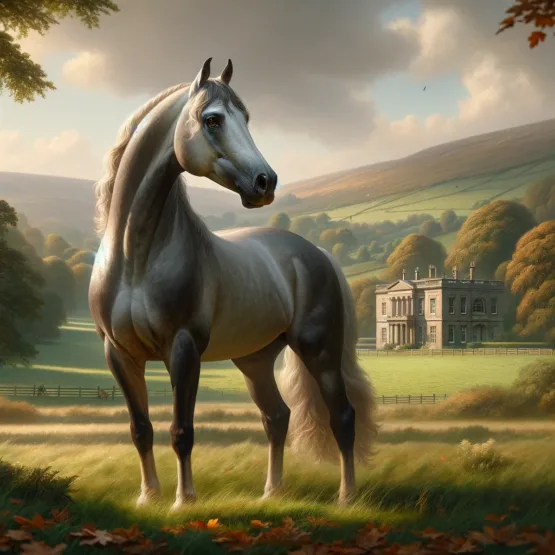
Marengo’s Legacy and Influence
Marengo, far more than a mere horse, evolved into a symbol of Napoleonic power and military prowess. His story, intertwined with that of one of history’s most iconic leaders, has left an enduring imprint on military history, equestrian breeding, and popular culture.
Symbol of Power and Prowess: Marengo’s association with Napoleon Bonaparte elevated him to a status beyond that of a typical warhorse. He became an emblem of the Napoleonic era, representing not only the military genius of his rider but also the strength, resilience, and endurance that were hallmarks of this period in European history. His image, often depicted in paintings and sculptures alongside Napoleon, became synonymous with the power and reach of the Napoleonic Empire. Marengo was not just a horse; he was a living embodiment of an era defined by conquest and ambition.
Influence on Military Horse Breeding: Marengo’s qualities – his endurance, intelligence, and temperament – were highly regarded in the context of military horse breeding. As a superb example of the Arabian breed, he influenced the breeding programs aimed at producing horses for military use. Breeders sought to replicate the traits that made Marengo such an exemplary warhorse, recognizing the crucial role these characteristics played in the effectiveness of cavalry units. His legacy in horse breeding underscores the importance of selecting traits that ensure both the physical ability and mental resilience necessary for horses in the rigors of warfare.
Enduring Legacy in Popular Culture: Marengo’s influence extends beyond military and equestrian circles into the broader realm of popular culture. He has been immortalized in art and literature, featuring in numerous paintings, novels, and historical accounts. These portrayals often highlight his loyalty, bravery, and the extraordinary bond he shared with Napoleon. Marengo’s story resonates not just as a tale of a remarkable horse but as a narrative rich in historical significance, symbolizing the bond between human and horse under the most challenging circumstances.
Artists and writers have been captivated by Marengo’s story, using it to explore themes of loyalty, war, and the human-animal bond. In art, Marengo is often depicted in battle scenes, showcasing the drama and intensity of his life. In literature, he is portrayed as a loyal companion, enduring the trials of war alongside his famous rider. These cultural representations contribute to Marengo’s lasting legacy, keeping his story alive for future generations.
Marengo’s legacy is multifaceted – he is remembered as a remarkable individual horse, a symbol of a significant historical era, and an influence on the breeding of military horses. His story continues to captivate and inspire, a testament to the enduring fascination humans have with horses and the profound roles these animals have played in shaping our history.
Conclusion
Marengo’s life story, entwined with that of Napoleon Bonaparte, stands as a remarkable testament to the profound bond that can exist between a great leader and his steed. This legendary Arabian horse, celebrated for his role in some of the most pivotal battles of the Napoleonic era, epitomizes not just the physical attributes desired in a warhorse, but also the mental resilience and unwavering loyalty that define the best of their kind.
Marengo’s journey from the battlefields of Europe to his final days in England encapsulates more than the life of a single horse; it reflects a broader narrative about the role of horses in human warfare. His story is a vivid reminder of the countless equine companions who have served alongside their human counterparts, often under conditions of extreme hardship and sacrifice. Marengo’s resilience, courage, and steadfastness in the face of adversity symbolize the innumerable contributions of these noble animals throughout history.
The enduring fascination with Marengo extends beyond his connection to Napoleon. It resonates with the timeless intrigue that humans have with horses, highlighting their integral role not only in warfare but in the shaping of human history. Marengo’s legacy, preserved in art, literature, and the annals of military history, continues to captivate and inspire. It serves as a poignant reminder of the enduring bond between humans and horses, a relationship founded on mutual respect, trust, and an unspoken understanding that has transcended centuries.
In reflecting on Marengo’s life, we are reminded of the extraordinary capabilities of horses and their significant impact on historical events. Marengo’s story is not just about a horse who served a famous leader; it’s about the enduring spirit, loyalty, and bravery of all horses that have played critical roles in human endeavors. His legacy is a powerful tribute to these magnificent creatures and their place in both our past and our hearts.
Read about another famous horse Alexander the Great’s Bucapholas
References and Further Reading
To delve deeper into the fascinating story of Marengo, Napoleon’s campaigns, and the broader role of horses in military history, the following sources offer rich, detailed information:
- “Marengo: The Myth of Napoleon’s Horse” by Jill Hamilton: This book offers an in-depth look at Marengo’s life, debunking myths and providing factual insights into his journey alongside Napoleon.
- “Napoleon’s Horses” by Raymond Horricks: This comprehensive work explores the horses that played a pivotal role in Napoleon’s life, including a detailed account of Marengo’s experiences.
- “War Horse: A History of the Military Horse and Rider” by Louis A. DiMarco: This extensive study provides a broader context of the use of horses in military history, offering valuable insights into the role that horses like Marengo played.
- “Napoleon: A Life” by Andrew Roberts: For a comprehensive understanding of Napoleon’s campaigns and military strategies, this biography is an essential read. It provides context for the battles in which Marengo was involved.
- “The Nature of Horses: Exploring Equine Evolution, Intelligence, and Behavior” by Stephen Budiansky: To understand the characteristics of horses like Marengo, especially in terms of their intelligence and behavior, this book is highly recommended.
- “The Arabian Horse: History, Mystery, and Magic” by Hossein Amirsadeghi: This book delves into the history and characteristics of the Arabian breed, providing a backdrop to Marengo’s lineage and qualities.
- “The Campaigns of Napoleon” by David G. Chandler: For those interested in the military tactics and campaigns of Napoleon, Chandler’s work is a detailed and authoritative source.
- “Horses in Society: A Story of Animal Breeding and Marketing Culture, 1800-1920” by Margaret E. Derry: This book provides an interesting perspective on the breeding and use of horses in the 19th century, relevant to understanding Marengo’s world.
- Journals and Articles: Academic journals such as “The Journal of Military History” and “Equine History Review” often publish articles on horses in military history, offering scholarly insights into their roles and significance

Napoleon and Marengo
Marengo was the prize war horse of Napoleon. He carried him through many battles including Waterloo, where he was captured. He died at age 38.

Marengo’s makeover
Marengo belonged to the French Emperor Napoleon Bonaparte. He was an Arab horse, small and grey, and named after the Emperor’s victory at the Battle of …

